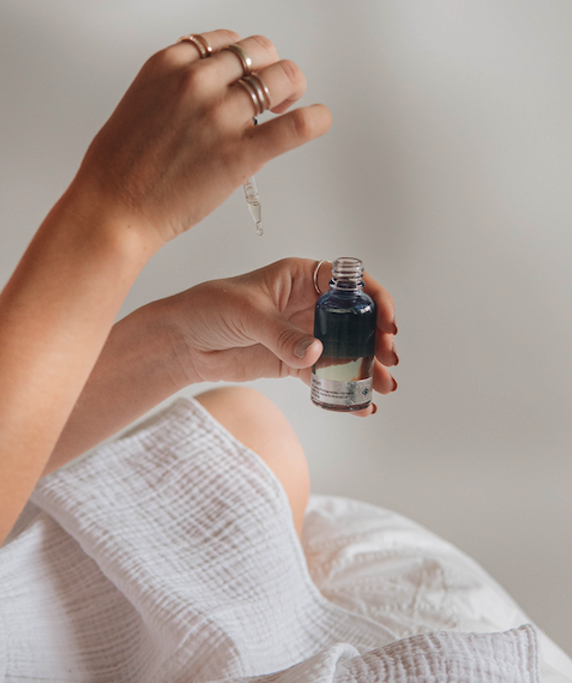Skincare Oils vs. Serums: Which One is Right for You?
Skincare Oils vs. Serums: Which One is Right for You?
The makeup industry is full of interchangeable products: lipsticks that work as cream blush, contour powders that create subtle definition in the eye crease, skin tints that you can layer on for a foundation-like finish — the list goes on. Things can get a little tricky when it comes to skincare products, especially when it comes to oils and serums. At first glance, they may seem interchangeable, but they feature vast differences that will affect your complexion's final results. If you are considering adding either product to your skincare routine, it is important to know what they each do, which skin type they suit best and the ingredients to seek out when shopping.

Expert Tip:
In addition to their different functions, serums and oils sit in different places of your skincare routine. While you should apply serums underneath moisturizer, oils are best used after moisturizer due to their thicker consistency. Zensa Healing Cream is a rich yet quick-absorbing moisturizer that works equally well sitting underneath oils and on top of serums. It contains calendula and grapefruit oil to nourish the skin and accelerate healing as well as cucumber extract to calm any irritation, making it ideal for sensitive skin types prone to inflammation or acne.
Below, we consulted with Dr. Anna Chacon, a Miami-based board-certified dermatologist specializing in medical, surgical and cosmetic dermatology, to learn all about serums and oils, including how they differ and when to apply each.

What Is a Facial Oil?
A facial oil's main functions are to "reinforce the skin barrier, seal in moisture and provide a radiant glow," says Dr. Chacon. Oils can benefit all skin types no matter the season, but they are particularly good for those experiencing dryness in cold weather conditions, as an oil's naturally thicker consistency will help replenish lost moisture. Though it may seem contradictory, those with oily skin can also use an oil — just make sure you are choosing the proper formula that contains non-comedogenic oils like squalane and grapeseed oil. According to Dr. Chacon, certain oils can also deliver specific, more targeted benefits such as soothing irritation (like chamomile oil) or reducing the signs of aging (like argan oil).
What Is a Facial Serum?
A facial serum is "a lightweight product designed to deliver a high concentration of active ingredients directly into the skin," says Dr. Chacon. "Its primary function is to address specific skin concerns like wrinkles, dark spots or acne." Like oils, serums can be beneficial for all skin types, but because serums are water-based, those with oily skin types may find them to feel more weightless and comfortable on the skin than oils.
Serums can oftentimes contain potent exfoliating acids like beta-hydroxy acid (BHA) and alpha-hydroxy acids (AHA) that may be irritating on sensitive skin types, so it is important to choose wisely and according to your skin type and needs. If you are concerned with an adverse reaction, consider conducting a patch test before introducing a serum into your routine, says Dr. Chacon. Some common ingredients you will see in a serum are salicylic acid, a BHA that helps balance oil production, glycolic acid, an AHA that boosts collagen production and niacinamide to brighten.
What Are the Differences Between a Facial Oil and Facial Serum?
-
Function: An oil's main purpose is to combat dry, dull skin by keeping the skin barrier intact. The skin barrier is the uppermost layer of skin that is in charge of both sealing in moisture and preventing it from seeping out, but it can become damaged due to things like UV rays, over-exfoliation and stress. Oils help replenish the skin barrier by creating a hydrating, protective layer. Serums, on the other hand, are used to address a specific skincare concern, be it hyperpigmentation, breakouts, fine lines or dehydration. They do this by using certain active ingredients: exfoliating acids like AHAs and BHAs, skin brighteners like niacinamide and vitamin C and wrinkle-reducers like retinol and peptides.
-
Consistency: "Oils generally have a thicker and heavier consistency compared to serums, which are lightweight and absorb quickly into the skin," says Dr. Chacon. Because of an oil's highly viscous consistency, they are often better suited as part of your nighttime routine, whereas a serum's more fluid consistency lends itself to your morning and nighttime routine. In any case, each product type's consistency also plays a role in which skin type it is best for. Those with dry skin may find an oil's thicker consistency to be a welcomed addition to an otherwise dry complexion while those with oily skin will appreciate the barely-there feel of a serum.
-
Application: According to Dr. Chacon, serums should be applied after cleansing and toning but before moisturizing to allow their active ingredients to penetrate the skin. "Oils, due to their heavier texture, should be applied after moisturizers to lock in hydration," she says. Generally speaking, it is important to apply products in the correct order, from lightest to heaviest, for best results.
-
Ingredients: Oils and serums differ when it comes to ingredients. Oils often contain antioxidants, vitamins and plant extracts and are naturally more moisturizing whereas serums have more potent ingredients like retinoids and exfoliants, which can help improve the look of wrinkles and acne.

Recap
Both facial oils and serums offer unique benefits and can be incorporated into your skincare routine based on your specific needs and concerns, says Dr. Chacon. Serums have a watery or gel-like consistency that allow them to penetrate deeply into the skin whereas oils have a more emollient texture to create protective barrier on the skin's surface. In any case, both oils and serums are typically housed in standard bottles with dropper applicators and are best applied using a light pressing motion to ensure proper absorption.
